Impact Factor : 0.548
- NLM ID: 101723284
- OCoLC: 999826537
- LCCN: 2017202541
SO Gladkov*
Received: September 06, 2022; Published: October 17, 2022
*Corresponding author: SO Gladkov, Moscow Aviation Institute (National Research University) (MAI) 125993, Moscow, Volokolamskoye highway, 4, Russia
DOI: 10.26717/BJSTR.2022.46.007388
It has been strictly analytically proved that there is a possibility of an external low- frequency EM field and resonant acoustic field influence on oncological diseases so that to destroy the diseased cells of the body. A numerical estimate of the frequency range in which this is carried out is given.
Keywords: Low-Frequency Em Field; Acoustic Influence; Frequency Range
In previous author’s works [1-3] we investigated some individual cases of the manifestation of the body’s reaction to the influence of external variables of electromagnetic (abbreviated – EM) fields. In this paper we will continue our research in this direction and try to answer the question of finding the frequency range in which the destruction of the affected cells is possible. In this message, we will expand the search a bit and consider acoustic fields along with an alternating electric field. As we will see later there is a certain frequency range in reality when such a possibility is realizable. It is also worth noting that when any magnetic additives for example iron or manganese are artificially introduced into the body cell structure affected by oncology the reaction of these cells to the alternating magnetic field becomes much more effective. At the same time the same natural question arises: is it possible to find such a frequency range of the external alternating magnetic field so that the affected cells begin to collapse as well as in the result of exposure of the body to alternating electric and acoustic fields? It would be biased on our part not to say that work was carried out in this direction but in the vast majority it was purely experimental research. However, although a number of works are theoretical in nature (see for example [4-11] the approach discussed below allows to find specific values of “therapeutic” frequencies. Further on we will focus on the study of the effects on the body of electric and acoustic fields only and we will not consider the magnetic field yet.
Consider this situation. Let a constant electric field E0 affect the body for a certain period of time Δt . Time Δt is defined as the time of occurrence of a polarizing moment p induced in each affected cell by a constant and uniform field means that if the body is additionaly exposed to the alternating field

Where E'0 −, is its amplitude and ω is the frequency the induced dipole moments dc will begin to oscillate. The lower index c indicates that we are talking about a diseased cell. The connection of the dipole moment vector with polarization as it is known [12] is determined in our case by the dependence

where vc − is the volume of one cell. Based on the motion equation ma = F where m− is the mass of the cellular matter exposed to the electric field and the force acting on it is determined by the expression

where q- is the charge induced by the field E0 in accordance with the dependence (1) we have

where ro -is one integration constant. The second constant is set to zero. It follows from (4) that the dipole moment according to the definition of [13] but in relation to our problem is That is

Hence the internal energy of the cell resulting from the superposition of both electric fields based on the general definition of [12] namely E1 = −d.E according to (1) and (5) will be

Taking also into account the energy of the cell surface tension ac which should keep it from disintegrating the total energy taking into account (6) may be represented as

where sc - is the total cell surface area. We will introduce the average density of the diseased cell pc into consideration and we will consider it a sphere with radius Rc for simplicity. As a result the total energy (7) may then be rewritten as follows:
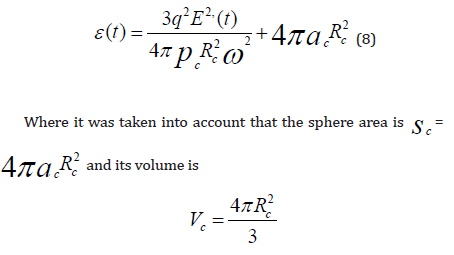

To find the full force acting inside the cell expression (9) should be differentiated by radius Rc . As a result we get

Based on the condition F ≥ 0we find the threshold value of the frequency at which the cell destruction process should occur

Formula (11) answers the first question about the theoretical possibility of the external electric field influence on oncological diseases. Upper frequency threshold (right side in (11))

may be estimated based on the following numerical values of the parameters. The cell density may be set equal to the water density
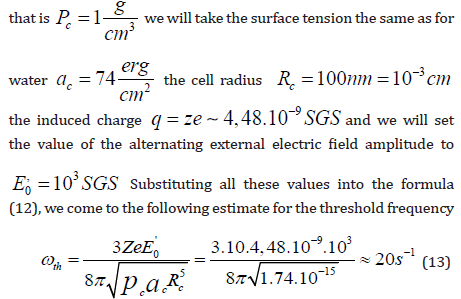
Such a frequency in the case of EM oscillations corresponds to approximately a kilometer wavelength range.
It is worth emphasizing that since both healthy and diseased cells are quite close in physical parameters great caution should be exercised here and it is necessary previously purely experimentally determine all the physical indicators of oncological and healthy cells. After that it will be possible to say quite definitely which specific frequency not affecting healthy cells should lead to the death of the diseased cells.
In order to assess the influence of an acoustic wave on the cell we will proceed as follows. Let ξ =ξ (x, y) -be the deviation of the cell surface points associated with an external acoustic influence from some of its average value (see Figure 1) Rc. As a simple approximation we will consider the cells to be ideal spheres of radius Rc. If the cell surface tension is denoted as s a (in dimension this is the energy attributed to the unit of its surface) and the surface density as ps which is defined in the usual way in the form s ps = dm/ds where dm- is the mass of cellular matter in the surface layer dS . Then the total internal energy of the cell may be represented as the following additive expression:

Then provided that the surface deviation is slight compared to the radius that is ξ << Rc we have the right to represent expression (15) as a decomposition

Omitting an insignificant constant we write expression (14) taking into account (16) in a more general form assuming that the shift ξ is a vector ξ

Finding the variation of functional (17) by ξ and setting it to zero we come to the equation
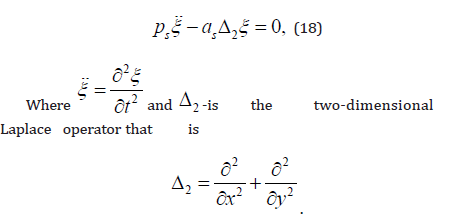
In equation (18) it is also necessary to take into account the external force which should appear in its right part. In the hydrodynamic approximation given that a human body is eighty percent water the role of this force should be reduced to a pressure gradient (see [9]) which eventually leads to the acoustic influence we are interested in. That is instead of (18) the equation should be written
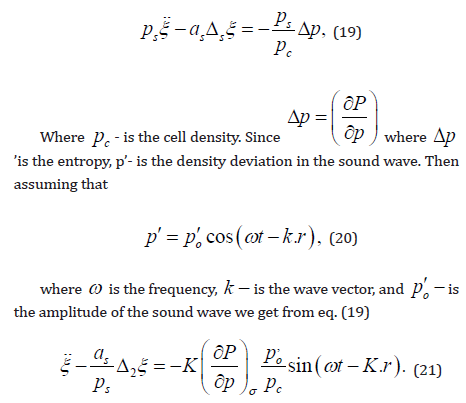
Choosing vector ξ in the radial direction and assuming that the wave inside the cell is homogeneous that is its length λ significantly exceeds the linear size of the cell Rc and this in turn allows to assume that the length of the wave vector may be represented in the

The partial derivative appearing here may be transformed as follows. We will proceed from the state equation of an ideal gas [8] according to which pvc = Kb NTc , where kB - is the Boltzmann constant, N- is the number of particles, and Tc – is the temperature of the cell. Modifying the Clapeyron-Mendeleev equation for our case we may write that

where mc- is the effective mass of the inner part of the cell. Based on the formula

where Cp − is isobaric heat capacity taking into account the dependence (23) we obtain

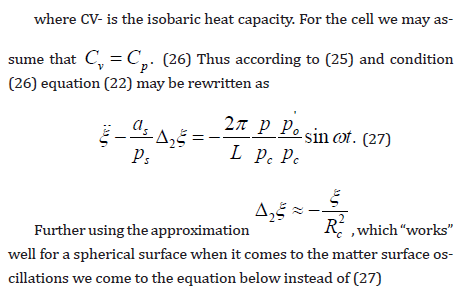
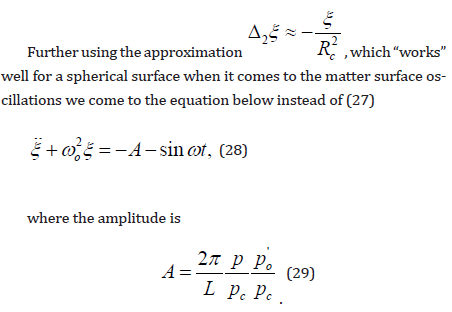
And the natural frequency of the cell surface oscillations

The resonant solution of equation (29) is found trivially and as a result we find

where we have formally introduced attenuation γ which must satisfy the condition

At resonance the wave amplitude appearing in solution (31) takes the value

Let’s estimate the values of frequency ωo have and amplitude B . According to (30) we

And according to (29) and (33) we get

In the CGS system the pressure may be set equal to P =104 SGS . The attenuation based on the inequality (32) and the estimate (34) let be equal to γ =10s−1 The length of the inhomogeneity may be set equal to the linear size of the cell that is L= 2Rc. Thus, we will have from (35)
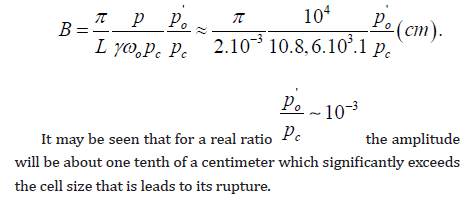
Concluding this message we note.
1. It is shown that at a frequency close to the ultrasonic threshold
(formula (30)) acoustic oscillations may well lead to the destruction
of the diseased cells.
2. For the alternating electric fields the frequency must be extremely
low that is the EM wavelength is very large and that
practically allows us to deem the applied electric field to be
simply homogeneous.


